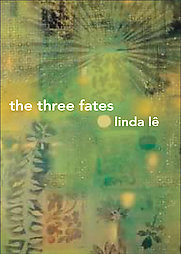Note: Linda Le was WINNER of France’s Feneon Prize in 1998.
“For twenty years King Lear had been watching the world spin without him. For twenty years he had not budged from the blue house where my cousins had left him. From his ruined palace, he had witnessed the exodus of the runaways, the year when Saigon had changed hands. And now he saw the return of the saprophytes, and King Lear snickered by his window.”
Vietamese- born Linda Le, one of France’s most popular authors, moved to Paris in 1997 when she was fourteen, accompanying her mother, grandmother, and three sisters soon after the fall of Saigon. In this energetic, sometimes raucous, and always surprising novel, Le describes the lives of three other young Vietnamese women who are also living in France—now totally assimilated after twenty years of living there. Two sisters, known as Elder Cousin, or Potbelly, who is pregnant, and her younger sister, Long Legs, a “cutie” who is living with someone she hopes is a ticket to wealth, have decided to invite their estranged father, King Lear, to come from Saigon to Paris for a three-week visit. Potbelly will pay for the trip, since she is married to a wealthy French “Hardware Man” in the “nutsandbolts business” who will be away during the visit; Long Legs has no money, spending her small salary on clothes, makeup, and trinkets. The third member of the Three Fates, Southpaw, referred to at one point at Albatrocious, is their cousin, a young woman who has lost a hand.
born Linda Le, one of France’s most popular authors, moved to Paris in 1997 when she was fourteen, accompanying her mother, grandmother, and three sisters soon after the fall of Saigon. In this energetic, sometimes raucous, and always surprising novel, Le describes the lives of three other young Vietnamese women who are also living in France—now totally assimilated after twenty years of living there. Two sisters, known as Elder Cousin, or Potbelly, who is pregnant, and her younger sister, Long Legs, a “cutie” who is living with someone she hopes is a ticket to wealth, have decided to invite their estranged father, King Lear, to come from Saigon to Paris for a three-week visit. Potbelly will pay for the trip, since she is married to a wealthy French “Hardware Man” in the “nutsandbolts business” who will be away during the visit; Long Legs has no money, spending her small salary on clothes, makeup, and trinkets. The third member of the Three Fates, Southpaw, referred to at one point at Albatrocious, is their cousin, a young woman who has lost a hand.

The sisters have few expectations regarding their reunion with King Lear, and Long Legs does not even remember the language, but they do plan to impress him with their financial and social success in France and show him how “French” they are. They were kidnapped from King Lear by their wealthy grandmother, Lady Jackal, who informed her penniless son-in-law of their departure for France through a photograph of their leave-taking which the photographer delivered to him after the boat sailed. Left behind in Saigon, King Lear has observed the changes in the country for the past twenty years, accompanied not by any family members but by The Wheezer, a priest who was tortured, his vocal cords and tendons cut by the communists, and who no longer celebrates the Mass, referring now to the Butcher on High and the Great Deaf-Mute in the Sky. He hangs around King Lear hoping for a meal of his favorite fried eel.
The story, such as it is, is told primarily through Southpaw, but it switches, without warning, to other characters, sometimes in succeeding sentences. Since the author has chosen not to include any paragraphing (which leads to many pages of gray, margin-to-margin text), the reader has few visual clues regarding shifts in voice and changes in speakers, a challenge for the reader who must depend on context clues. Despite this, the story is relatively easy to follow at the beginning of the novel. As the scenes become a bit more complex, and the author conveys dream sequences, memories, and imagined events, however, the novel begins to resemble a long, symbolic poem rather than a novel. Remarkably little symbolism relates to the Shakespearean play of King Lear, and that conceit is relatively undeveloped, the characters not really paralleling King Lear as Shakespeare has created him. But other symbols, of Bluebeard, dragons, witches who remove hands, soldiers, and even of a shrimp which is about to be fried take their place. The fairly straightforward narrative of the early part of the novel becomes much more “internalized” by the author, and the voices of the speaker(s) become more dream-like and nightmarish as a fever of words and images is disgorged for the reader to interpret.
 Many great scenes will stick in the reader’s mind, especially as King Lear remembers the reunification of Vietnam and the departure of the American soldiers, but among the most memorable are those which connect to the characters with whom the reader can really identify. When Elder Cousin (Potbelly) gets married, for example, she sends the lonely King Lear photographs from the wedding, but he cannot bear to open them, leaving them in their envelope for days until he can get dressed in his “swanky suit,” more appropriate for the occasion, when he finally opens them. That one scene does more to convey emotion than almost any other scene in the novel, and it is among the most “honest” scenes in the book.
Many great scenes will stick in the reader’s mind, especially as King Lear remembers the reunification of Vietnam and the departure of the American soldiers, but among the most memorable are those which connect to the characters with whom the reader can really identify. When Elder Cousin (Potbelly) gets married, for example, she sends the lonely King Lear photographs from the wedding, but he cannot bear to open them, leaving them in their envelope for days until he can get dressed in his “swanky suit,” more appropriate for the occasion, when he finally opens them. That one scene does more to convey emotion than almost any other scene in the novel, and it is among the most “honest” scenes in the book.
Sometimes the novel feels like an aria being sung to an audience in an operatic language the reader does not understand, but just as often it feels like a poem being read to a sympathetic audience of people who can identify with the feelings, if not the events. The artificiality of the construction and the arch, even academic, attitudes—including a large amount of mockery of people and their points of view (which I, personally, found offensive)—may add to the “humor” of the narrative, but it is a cynical, sometimes snide humor which ignores one of the primary functions of fiction—to communicate, instead of standing apart and making not always sympathetic observations about the efforts of others to deal with the life that fate has handed them. The descriptions and the musicality of the language are superb, but sometimes I felt as if I were being involved in a literary free-for-all when what I wanted was to understand the feelings of the characters who were facing very real and difficult problems.
Notes: The author’s photo is from http://www.nyu.edu
The newspaper of the fall of Saigon is from http://unit8belay.wikispaces.com
